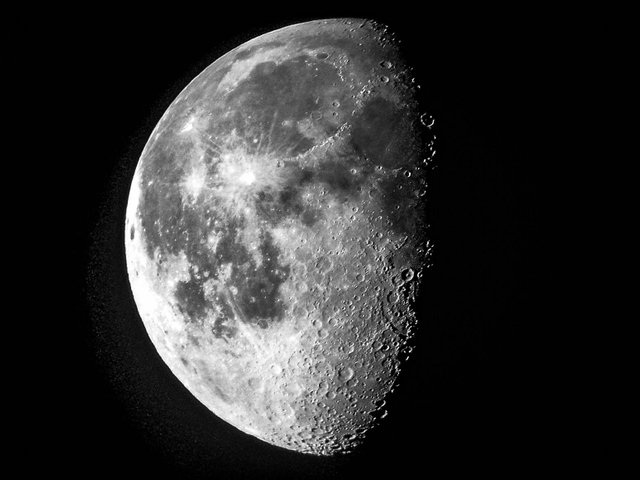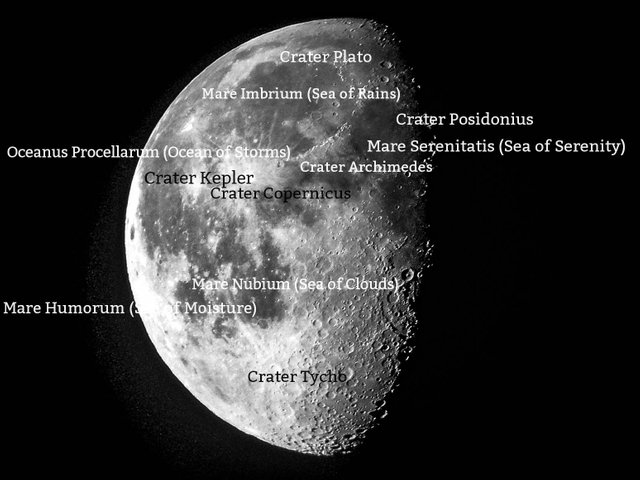Moon Map

The Moon is my favourite object to observe. It is a starting point to get to know what is in the skies above. The surface of the near side is covered with dark plains seen with naked eye. First look through the telescope reveals the rough relief and the numerous craters. The next thing I wanted to know is how they are called and to collect as much information as possible.
There are many sites providing detailed information about lunar surface together with maps. Nonetheless I have created my own using the image I took on Tuesday.

Let me show you around and tell you what I have seen through the telescope.
Crater Plato is named after the ancient Greek philosopher Plato. It is located on the northeastern shore of the Mare Imbrium. The age of the crater is approximately about 3.84 billion years.
Diameter 100.68 km
Mare Imbrium ("Sea of Showers" or "Sea of Rains") is a lava plain.
The name sea was given to the dark basaltic planes formed by the volcanic eruptions. Early astronomers thought the dark plains for water and hence they were called seas or mare in Latin. (maria in plural)
Diameter 1145.53 km
Crater Posidonius is named after ancient Greek philosopher and geographer Posidonius of Apamea.
Diameter 95.06 km.
Mare Serenitatis (Sea of Serenity), like other marie were formed firstly from impacts of asteroids and later covered with lava from the volcanoes. The flat surface was again hit by asteroids creating smaller crates within the plain.
Diameter 674.28 km
Crater Archimedes, named after the ancient Greek physicist and mathematician is located on the eastern edges of the Mare Imbrium
Diameter 81.04 km
Oceanus Procellarum (Ocean of Storms). The biggest plain is called ocean, due to its size, covering an area of roughly 4,000,000 km2.
Diameter 2592.24 km
Crater Kepler is named after the German astronomer and mathematician Johannes Kepler.
It lies between the Oceanus Procellarum to the west and Mare Insularum in the east.
The crater is notable for its ray system. The rays extend over 300 km.
Diameter 29.49 km
Crater Copernicus, named after the Polish astronomer.
The crater also has prominent ray system.
Diameter 96.07 km
Mare Nubium (Sea of Clouds) is located just to the southeast of Oceanus Procellarum.
Spanish astronomers witnessed an impact of a meteorite in Mare Nubium in 2013.
Diameter 714.5 km
Mare Humorum (Sea of Moisture) is one of the smaller maria.
Diameter 419.67 km.
Crater Tycho, named after the Danish astronomer Tycho Brahe, is estimated to be 108 million years old, which makes it relatively young crater. It is surrounded by a distinctive ray system forming long spokes that reach as long as 1,500 kilometers.
Diameter 85.29 km
Of course there are much more to mention. The list is very long. Each crater, sea and mountain is named.
Once you know them and where to look, the pleasure of exploring the surface through the scope is bigger.
The image is taken with Nokia N8 smartphone through the eyepiece of the telescope.
Phase of the Moon - Waning Gibbous.
Source of information - Wikipedia and Observatorio ARVAL - Moon Map


Thank you for visiting.
If you like to share your thoughts you can leave a comment.

[email protected]🌐
eSteem.app | 👨💻GitHub | 📺YouTube✍🏻
Telegram | 💬Discord



I recently saw a post on reddit, where someone posted an extremely high resolution image of the moon. It was fascinating the level of detail they captured down in the craters.
It is possible now with good camera to photograph the Moon. Photos are sharp and clear. I have seen some truely remarkable photos made just with camera, without telescope. I have made zillion of pictures when I brought the telescope, using mainly the phone camera.
Its honestly amazing just how good cameras have become in say... the past 10 years. The quality of images we can capture... with our phones.. astonishes me. Truly.
This post has been voted on by the SteemSTEM curation team and voting trail in collaboration with @curie.
If you appreciate the work we are doing then consider voting both projects for witness by selecting stem.witness and curie!
For additional information please join us on the SteemSTEM discord and to get to know the rest of the community!
Thank you very, very much!
Thanks for mentioning eSteem app. Kindly join our Discord or Telegram channel for more benefits and offers on eSteem, don't miss our amazing updates.
Follow @esteemapp as well!
WOW what a cool moon shot and awesome you made a moon map from it :)
I found out that the old phone camera is still good enough. :-)
This post has been upvoted by the ASTROSteem curation team and curation trail.
ASTROSteem is a project with the goal to promote and support astronomical content on the STEEM blockchain. If you wish to support the authors of astronomical content and the ASTROSteem project you can get more informations here.
Amazing how they can age the craters.
Indeed, it is amazing. The best way is by analyzing the sample rocks brought by the Apollo missions.
Страхотна работа Нели!
Благодаря сърдечно.
Every time I read a post from you, I envy you! Those pictures are so lovely (I will let you know if/when I will buy such an apparatus) :D
😀 Aww, thank you. I bet once you have a telescope you will make better pictures.
I guess I will start simply... by making pictures. I don't make any for now, limited by the (non existing) material I have :)